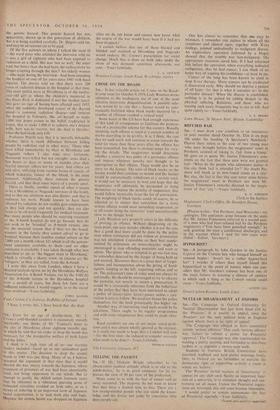THE SCIENTISTS AND THE BOMB SIR—The most fitting person to
reply to Rudolf Peierls's article in your issue of October 16 would ba Dr. Fumio Shigeto, Director of the Hiroshima A-Bombs Victim Hospital, with whom I had an inter view when in Hiroshima last May. Following this interview I met and talked with, through an able interpreter, five of the patients, who had kindly--and courageously—consented to meet me.
Dr. Shigeto showed me an album of horrifying photographs of radiation burns—in some instances the pattern of materials had burned into the patient's flesh like some kind of frightful tattooing—but he emphasised to me. when I exclaimed in horror, that terrible as these injuries were, leaving the patient who did not die of them most terribly scarred for life, more, terrible still was what he called the 'deep inner injurY. F thought that he meant radiation diseases—leukxml° and cancer in various forms—but he went on to ea; plain that he meant the harm done to the psyche 01 the victim. Professor Peierls perhaps does not know, that surviving A-bomb victims feel themselves, and have in fact become, a people apart, since few people, will knowingly marry an A-bomb victim for fear or the genetic hazard. This genetic hazard has not,. apparently, shown up in this generation of children, but it is being watched carefully, Dr. Shigeto told Me. and may be an account yet to be paid.
Of the five patients to whom I talked the most ill —the ward sister who attended the interview •told me —was .a girl of eighteen who had been exposed to radiation as a child. She was 'not so well,' the sister said, but better than she had been, the radioactivity no longer erupting through the skin.* An elderly woman -- -who wept during the interview—had been attending the hospital on and off for years since 1945 with head injuries. The doctor told me that .there were 200 cases of radiation disease in the hospital at that time. The most pitiful story in Hiroshima is of the twelve- year-old girl to whom the children's memorial in the Peace Park is dedicated (I met her mother later). She gave no sign of having been affected until 1955, when she suddenly developed cancer of the thyroid gland--a common radiation disease—and entered the hospital in February. She .set herself to make 1.000 tiny paper cranes in the belief, traditional in Japan, that to make 1,000 is to achieve one's deepest wish; hers was to recover, but she died in .October. When she had made only 630.
Professor Peierls says that it is 'morally debatable whether there is much difference between killing people by radiation and in other ways.' Those who were killed immediately by blast at Hiroshima and Nagasaki (where I also was) were fortunate; thousands were killed but not outright; some died a few hours or days or weeks or months after their fearful injuries; .others not for years. And others are still alive, suffering from various forms of cancer, of which leukemia, cancer of the blood, is the most common. Additionally there remains the genetic hazard, and that deep inner injury of a people apart.
There is, finally, another aspect of what it means to be a Hiroshima or Nagasaki survivor of the bomb, and to this my attention was also drawn; and that is unfitness for work. People known to have been affected by radiation do not readily gain employment, as they lack energy and tire quickly; they are also
• liable to be off work frequently for medical treatment. But many people who should be receiving treatment • at the A-bomb hospital do not go because they ,do not wish to be 'branded' as A-bomb victims, also
• for the material reason that if they are the bread- winners in the family they cannot afford to go to hospital, because their families cannot subsist on the 2,000 yen a month (about £2) which is all the govern- ment assistance available to them—and no other assistance is available. I was taken throUgh what was described to me as 'the biggest slum in Hiroshima,' which is virtually a shanty town; its citizens are the 'refugees,' as they arc called, from the A-bomb.
1 write this away from London, where I have a detailed analysis (given me by the Hiroshima Welfare Association for A-Bomb Victims, run by the YMCA) of the A-bomb- victims in the Hiroshima hospital Over a period of years, but thes few facts are a sufficient indication, I would suggest, as to the moral issue involved.—Yours faithfully,
ETHEL MANNIN Fuld, ('/1/den, Co. Galway, Re Ilhblic of Ireland
* Since I wrote this. 1 have heard that she died.











































 Previous page
Previous page